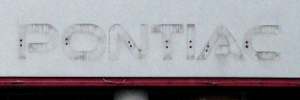















Pontiac brake drum: great stopping power with less effort |
|---|

|
Anthony Fontanelle
September 11, 2007
If you can make your car go, then you should also be able to make it stop. That is the reason why your car has been equipped with a braking system. It is made up of various car components that serve a unique role in the over all performance of your car. This group of safety components is among the most indispensable parts of your vehicle that slows down or stops your car. They do the stopping process through leverage and hydraulic force multiplication. Friction is also among the main elements of a successful braking assist. They have evolved into a more complex and more fool proof system over the years, so that the chances of having a total brake failure would be totally eliminated. That way, you will prevent yourself from engaging in a serious car accident. However, brake-related accidents happen if one or more of your braking system components have not been working properly. Having proper car maintenance and inspection would ensure that your braking system components are always in tip top shape, because you would be able to notice some wear and tears signs.
Your Pontiac brake drum is among the various parts of your braking system that aids in providing you with the braking assist that you need whenever you want to slow down or stop your car. It was first used in 1902, and was equipped with a mechanically operated drum shoes that features cables and rods. The friction caused by your Pontiac brake drum can be attributed to the brake pads and brake shoes that press against the rotating drum’s surface. Depending on the way the shoes are hinged, every brake drum has a “self-servo” characteristic. The rotation of the drum drags the shoes around with it, so your Pontiac brake drum is able to increase the stopping power of your car without the need of any additional effort by the driver. To utilize the servo characteristic, your front brake drums must use 2 actuating cylinders. That way, it would be able to prevent premature rear-wheel locking as well as to compensate for the forward weight shift.
Although brake drums are very useful, brake drums that are equipped with internal shoes have a disadvantage. Brake fade can happen when the drums are heated by hard braking. Due to the expansion of the material, the diameter of the brake drum would increase so the brakes must be depressed further to obtain an effective braking action. To compensate for the shoe and drum wear, brake drums are required to have periodic adjustment. This must be followed, because failure to do so would just result to long brake pedal travel. When left unsolved, your entire braking system would not be able to perform its intended function properly. For this reason, the front wheels of cars were replaced gradually by disc brakes. But brake drums are still used for vehicles equipped with handbrakes. Modern cars that use brake drums like your Pontiac employ simple incorporation of a parking brake. However, they are applied to rear wheels since there is lesser heat generated at the rear of the vehicle, and most of the stopping process happens in the front of your car.
Source: Amazines.com
